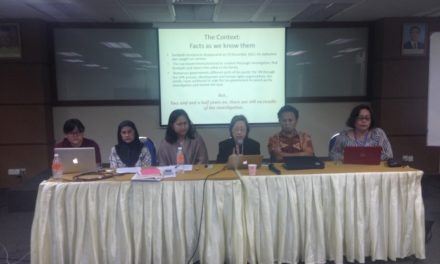Presentation at the 6th ASEAN People’s Forum, Hanoi
by Chanida Chanyapate Bamford
Focus on the Global South – September 2010
One of the impulses binding ASEAN together effectively has been the need to use its combined size as protection against external forces seen by member countries as threats to national political security. That is why ASEAN comprises countries with different historical backgrounds and different systems of government, which can only stay together if they keep looking outward together.
In the past decade, this outward-looking perspective resulted in various trade and economic partnership negotiations with external economic powers: Japan, China, the EU, the US and India. The Deputy Secretary-General has just confirmed to us here that ASEAN is prepared to talk with everyone; “We have no enemy”, he said.
I would like to point out that we have no need any more to look outside. The enemy is now within and among us.
By choosing to engage with the global market economy for the purpose of achieving rapid and high levels of economic growth, ASEAN has internalized the dominant neoliberal ideology. The dictate of this ideology is that free trade and investment agreements will generate the economic growth which is needed to alleviate poverty. But I would like to argue that, with this kind of engagement, ASEAN is internalizing the systemic risk, and the systemic social and environmental costs that are threatening the security of their peoples.
The Asian financial crisis of 1997 was the first warning sign of this risk. Over just a few weeks, almost all the foreign short-term investment capital that had flowed in over the previous years just disappeared. This capital flight left Thailand and Indonesia in poor economic shape; millions of people dropped below the poverty line. In Thailand, the average income decreased by 20%. Only Malaysia was able to avoid the resulting economic contraction by immediately imposing capital control measures, flying in the face of the conventional wisdom espoused by the International Monetary Fund.
The current financial crisis originated at the core of finance capital. It started with subprime mortgage dealings by banks and financial firms in the US involving complex financial deals cooked up to make profits through speculation. At least 3 trillion dollars (that is 3 with 12 zeros!) were said to have been wiped out on Wall Street.
The food crisis in 2008 was in large part due to self-fulfilling speculation in rising commodity prices by investors.
The key players in all these crises are investors maneuvering huge amounts of capital that has accumulated in the industrialized economies of the world. And their sole purpose of making profits, to accumulate more and more, in the easiest way possible.
By focusing on expediting economic growth as measured by GDP, ASEAN countries are laying themselves open and vulnerable to the same crises. Because we all rely on the US market for our exports that will bring us the growth, we all got burned when the income (and credit) of US consumers was curtailed and they cut down on consuming. Some ASEAN countries like Thailand and Singapore suffered a second recession in little more than a decade.
All the government stimulus packages to encourage consumer spending mean that economies have since grown and may keep growing for a while. China continues to import large volumes of raw materials to supply its rapidly expanding economy and has been a big boon to ASEAN’s agriculture sectors.
The big question is how long can the growth last.
The reality is that the current mode of production and consumption on which we are relying to produce economic growth has tremendous social and environmental costs.
The social side is already noted by the ASEAN Ministerial meeting in Hanoi a month ago in August: the gap between the rich and the poor is widening both within each country and between countries. The latest MDG assessment shows that the overall number of the poor has been reduced, thanks to China’s and India’s recent spectacular growth, but the number of hungry people around the world has actually increased!
This basically is the result of growth based on private businesses or corporations making the greatest profit by paying their workers as little as possible, and paying women even less than men.
Air and water pollution, the depletion of forests, soil fertility and marine and river fish stocks, and the loss of biodiversity are concrete environmental costs that can be felt by communities all over the ASEAN region.
The ultimate environmental cost is the phenomenon of climate change. The main culprit is the process of industrialization over the last 2 centuries that turned Europe and the US into the world’s economic powers of today. Carbon dioxide emissions from burning fossil fuels, i.e. coal, oil and gas, has created a greenhouse effect which is causing the earth’s surface temperature to rise much faster than in the whole of human history.
It is clear now that fossil-fuel based expansion of production and consumption that leads to economic growth has come face to face with the earth’s limits. It has been pointed out graphically by many that if everyone on earth consumed goods and services at the same level as people in the US, we would need 5 earths to support it.
Unfortunately, while there is some talk of developing more renewable and clean energy, the response of governments in ASEAN and elsewhere is an intensifying and competing effort to drill for more and more oil and natural gas. Large projects are being planned to appropriate natural resources (land, forests, water, biodiversity and minerals) for profit that would increase environmental damage, and cause more poverty and food insecurity in many areas.
While natural resource conflict is looming in the East China Sea, next to the old battle ground of the South China Sea, with a real potential to threaten the political security of ASEAN, the people of ASEAN are expected to absorb quietly all the social and environmental costs that directly affect them.
It is time, therefore, for ASEAN countries to stop competing among themselves to grow their economies by looking outward for more external markets and investment at the expense of their people’s health and welfare and their environment. The priority has to be shifted inward towards regional cooperation, based on solidarity and complementarity, in order to build people’s immunity against the finance-driven economic crisis, and set the course of development towards sustainable production and consumption and social equity.
The fact is clear that, for us, there can be no human security without environmental security. And, for ASEAN, there can be no political security without environmental security either.
I have confidence that if the peoples of ASEAN can see the big picture and see how all the security issues are linked up, they will join forces with us to work towards ridding ASEAN of the enemy within and changing the course of ASEAN towards a better future for all who share the natural resources of this region.







